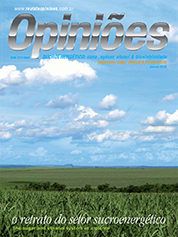Renato Augusto Pontes Cunha
President of Sindaçúcar - Pernambuco
Op-AA-25
Northeast: increase in competitiveness
We have known, since the Proálcool program, that the sugar-based energy industry in the Northeast enjoyed limited growth. It grew mostly in the plains in northern Alagoas and in the more sandy plains in Paraíba and Rio Grande do Norte. The region’s more traditional areas, consolidated in a mountainous topography, are capable of growing vertically, with gradual increases in productivity, resulting from the continuous and consistent work performed by the RIDESA network.
This year, this knowledge network in May launched 7 new plant varieties, suited for the environment and more robust for production in the Northeast, and hence, more resistant to hydric stress. The Rural Federal University of Pernambuco – UFRPE, operates a Sugarcane Experimental Center in Carpina, in the State of Pernambuco.
In this Center – EECAC -, since 1998, a public-private partnership in sugarcane research, between universities that integrate the RIDESA network and members of Sindaçúcar - Sindicato da Indústria do Açúcar e do Álcool (sugar and ethanol class entity), has been in operation. Its focus is on genetic improvement and it has been quite successful. In the 12 years of this partnership, 18 new varieties of sugarcane of the “RB” family were launched, having been developed for the Northeast.
This set of “RB” cultures already accounts for 60% of the region’s inventory, having increased the State of Pernambuco’s average productivity by about 15 tons per hectare. On the other hand, logistics has been the most important means to minimize and partially offset the Northeast’s higher costs. In the region, manual labor in agriculture is predominant, with a strong social focus, in contrast with the reality of Center-South Brazil, where the climate is more stable and, consequently, agricultural expenses incurred with cutting, loading and transporting (mechanization) are lower.
The comparative scenario between the two men-tioned regions favors the Northeast, based on adequate conditions to bring its produce to foreign markets, given that, on average, mills are located only 60 km from port terminals. The ports of Natal, Cabedelo, Recife, Suape and Maceió, in particular, have fewer bottlenecks than ports in the Center-South.
In this respect, in the zoning of the efficient Suape port, the newest in the Northeast, investments were already made in a modern refined sugar in bulk terminal, resulting in higher aggregated value of sugar destined to North Africa and the Mediterranean, which are regions that, prior to the World Trade Organization panel brought about by Brazil, Australia and Thailand in 2004/2005, were supplied from Europe (Antwerp).
Suape’s new “white product” terminal will enjoy an actual upgrading in terms of logistics, improving the sales equation, surely making it more stable and profitable. This is possible because of water depths of more than 15 meters, quite suitable for various kinds of ships, resulting in awards granted for quick loading. The Sugar Terminal of Suape, with a nominal capacity of 160,000 tons and hourly loading rate of 750 tons, will allow processing sugar in bulk, along with container filling in its yard and the loading of filled sugar bags, thereby operating as a multiple-purpose terminal.
Investments are estimated at US$ 60 million, with operations scheduled to start within the next three years. The project, in combination with investments currently in progress, particularly in the mechanized cutting of sugarcane plantations, may considerably valorize the region’s agro industrial units in the short term. In this regard, our associated mills, under the financial management of Sindaçúcar-PE, created a Technological Innovation Fund, based on initiatives focused on environmental sustainability, with the gradual reduction in the volume of burned sugarcane, even on slopes of agricultural areas. This initiative began in the traditional Petribu mill.
The Technological Fund hired the experienced engineer Raul Fernandes, who travelled to several countries around the world for 30 days in search of technology for harvesting on steep slopes. Success is beginning to show in tests performed at the Petribu mill with French, Japanese and Chinese equipment, suited for lowlands and slope angles varying from 12% to 70%.
One should also comment about another structural strategy for the region, intended for the topography we are dealing with, which relates to the capacity of generating bio-electricity from biomass of sugarcane bagasse, with the consequent retrofit of our thermal plants (boilers), seeking higher generation of MWh, by purchasing more modern and economic thermal plants. There is no doubt that the distribution of generated bio-electricity in the networks tends to grow, particularly if clean energy will be remunerated at rates that reflect the benefits brought about by our industry. It is a matter of time, because support for the environment is strong, authentic and sustainable.




